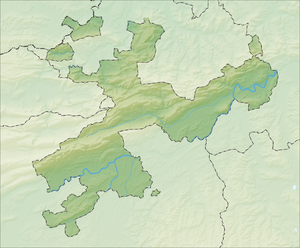Frohburg ruins
| Frohburg ruins | ||
|---|---|---|
|
The southern part of the restored wall remains at the fore |
||
| Creation time : | around 800 to 1100 | |
| Castle type : | Höhenburg, rocky location | |
| Conservation status: | ruin | |
| Standing position : | Count | |
| Place: | Trimbach | |
| Geographical location | 47 ° 22 '45 " N , 7 ° 53' 24" E | |
|
|
||
The Frohburg is the ruin of a rock castle in the municipality of Trimbach in the Swiss canton of Solothurn and is one of the largest medieval castle ruins in the Jura Mountains .
The castle ruin is classified as worthy of national protection and is therefore at the highest level of monument protection awarded in Switzerland .
location
Well-restored remains of walls have been preserved from the elongated castle complex on a high rock ridge above the Erlimoospass and the Untere Hauenstein near Olten .
history
The place was already populated in the Bronze Age and then again during the Roman period . In the 10th century, an important noble family in the Olten and Zofingen region settled on the Jura ridge. In the immediate vicinity of the castle, the castle and followers of the castle lords opened up new settlement land by clearing . Since the late 11th century, the family has appeared in the documents as the Counts of Frohburg . From the castle name sex deduced his name. Until the 14th century it dominated a large area of influence between the Aare and the Rhine in the old regions of Aargau , Buchsgau and Sisgau .
After the first modest settlement with wooden houses, the counts erected a large number of larger structures within the surrounding wall of the castle over the centuries. In addition to a count's house, service buildings and workshops were also part of the assembly. Of particular interest is a small smelting plant for iron , which was exploited as an important natural raw material in the Jura. In addition, the processing of leg has been proven to be another special trade . The castle had at least three water cisterns .
In the course of the 14th century, the Counts of Frohburg lost their privileged position, and the individual buildings in the family's ancestral castle were abandoned over time. When the counts died out around 1367, there were probably no more permanent residents in the complex, which has since fallen into ruin and has been used as stone stock by residents of the agricultural settlements in the area.
First investigations of the site before the middle of the 20th century and scientific excavations after 1970 yielded rich information about the settlement history of the castle.
An in-depth Germanic investigation carried out with the archaeological studies has shown that the castle name really means «Frohburg». This was the name given to the place in the area well into the early 20th century, and it was only in later decades that the incorrect spelling Froburg became widespread here and there due to an incorrect approximation of the name to the Old High German word group of fro (= Herr) .
Today the facility is one of the popular tourist destinations in the Olten region .
Web links
literature
- Werner Meyer (among others): Die Frohburg, excavations 1973–1977. Swiss contributions to the cultural history and archeology of the Middle Ages, Volume 16. Olten 1989.
- Paul Gutzwiller: The pre-medieval finds from the Froburg area near Trimbach / SO. Antiqua 18. Basel 1989.
- Werner Meyer: Castles from A to Z - Burgenlexikon der Regio . Published by the Castle Friends of both Basels on the occasion of their 50th anniversary. Klingental printing works, Basel 1981, pp. 200–202.
- Werner Meyer: The Frohburg. A guide through the castle ruins. Solothurn 1980.
- Hektor Ammann : The Frohburgers and the founding of cities. In: Festschrift Hans Nabholz, Zurich 1934.



